Tested: 2020 Land Rover Defender 110 SE Refines an Off-Road Icon
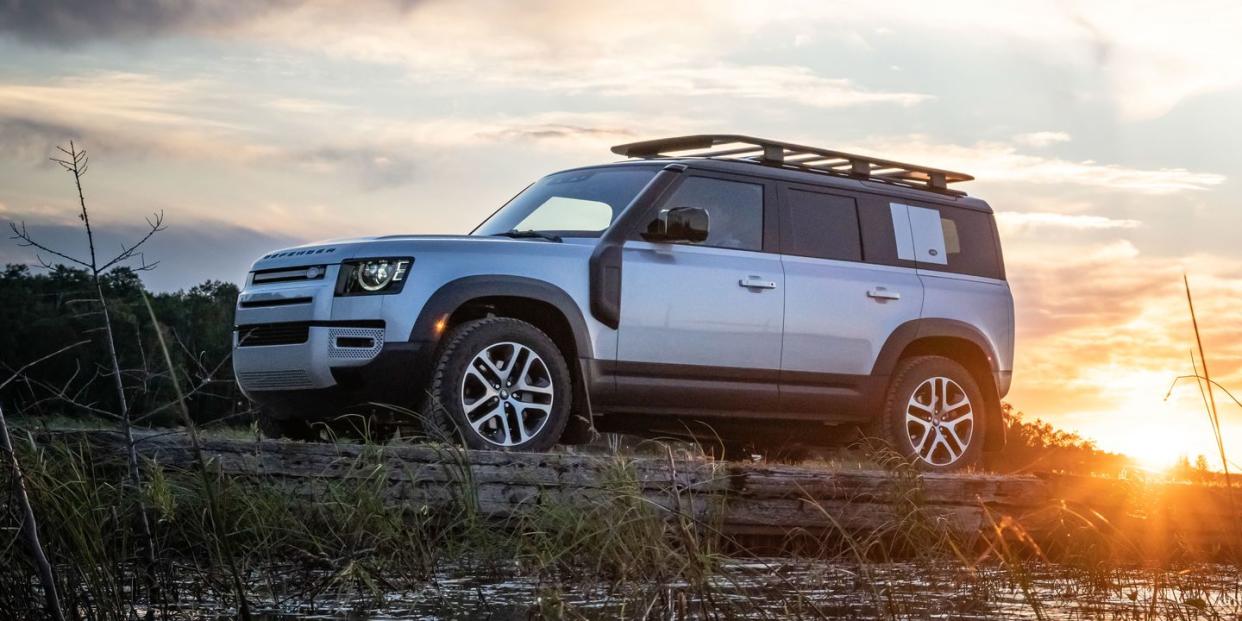
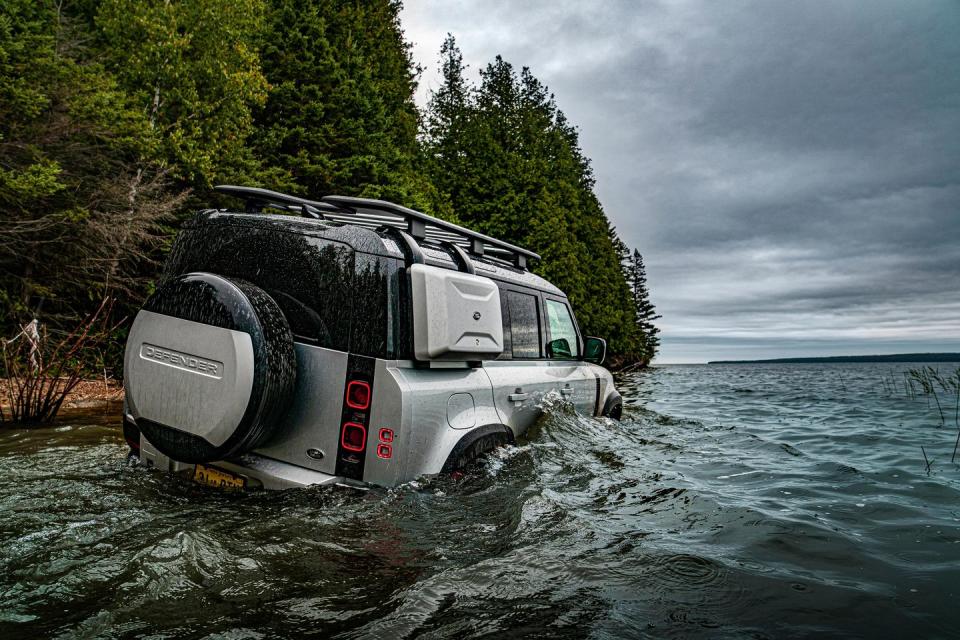
From the November 2020 issue of Car and Driver.
Land Rover has gone soft. While its Range Rovers are striking and urbane, everything in the lineup seems either too precious or too luxurious for mud-slinging off-road misadventure. The Land Rover Defender is supposed to fix that.
More than two decades have passed since Land Rover offered its archetypal nameplate in the U.S. This new one shares nothing with that truck other than a badge, but like the "Jeep Wrangler" and "Ford Bronco" monikers, the words "Land Rover Defender" are more than a name. This SUV has a reputation to maintain, a promise to live up to.
Built on Land Rover's new D7x architecture, the Defender ditches its ancestor's body-on-frame structure and stick axles for unibody construction and independent suspensions. Some might call it soft. Our thoughts? Put away the torches and quit living in the past, man. The Defender is no longer a wartime tool with an FM radio, and it's better for it. It still packs a low-range transfer case, but it derives much of its off-road capability from modern tech like air springs, digital trail spotters via 360-degree cameras, and sophisticated traction-control algorithms.
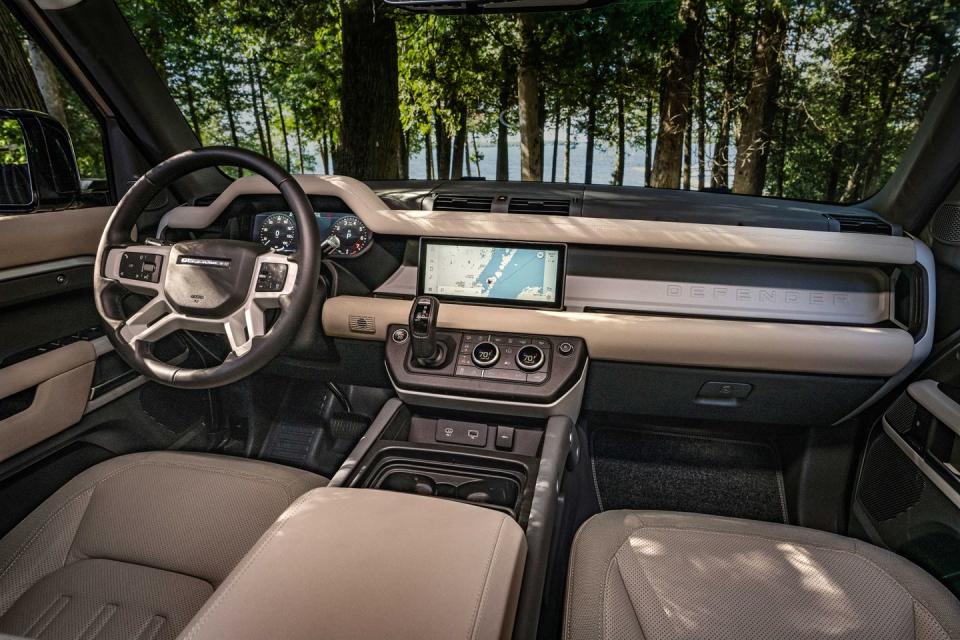
This new one will bushwhack a path into the woods and pamper your ass on a run to the mall. Our modestly equipped four-door 110 SE stuffed several luxuries into its $82,575 price, including adaptive cruise control, heated everything, and a panoramic roof. It was also dressed for adventure, with an optional electronically controlled rear diff, the most aggressive off-road tires available from the factory, and the $4800 Explorer pack that includes a platform roof rack, an intake snorkel on the driver's-side A-pillar, and an odd little cargo pod hanging off the side.
We took those accessories as a challenge and traveled to Drummond Island, an all-terrain paradise for Jeeps (and their competitors) off the easternmost point of Michigan's Upper Peninsula. For a crisp Andrew Jackson, the Drummond Islander IV will ferry any off-road rig and its keepers across the St. Marys River. From there, the fun begins.

The Defender's air springs pay dividends on Drummond's trails. Days of rain have greased the two-tracks with mud and filled the low-lying areas with water. In the truck's highest setting, 11.5 inches of ground clearance—the same as a Sasquatch-pack four-door Bronco and 0.7 inch more than a Wrangler Rubicon—keep the aluminum bash plates from meeting the suitcase-sized boulders.
It's difficult to grasp the Defender's size until you see it parked next to a Wrangler or navigating a dense forest. A towering 80.6 inches tall with the roof rack (83.5 inches all jacked up), it's barely short enough to duck under most of Drummond's tree limbs, and it's just narrow enough to avoid extensive trail rash on its bulging hips. The previous Defender's square edges have met the aerodynamic router, but any efficiency gains made from smoothing the edges are countered by the Explorer pack's extremities. The roof rack produces more wind noise than a gas-station burrito and most certainly was a factor in our lousy 15-mpg average.
Looking a bit toylike when clean, our Indus Silver example got more rugged with every splash of nature's paint. It rambled down the first trail at a steady pace, rolling effortlessly through deep holes and over small boulders until we were overlooking Lake Huron. It's clear that the "Stay on Trail" signs were hung before the lake rose to a near record level, because the path that once hugged the shoreline is all but gone. With nowhere else to go, we plunged into a chilly freshwater bath.

The Land Rover has a trick up its sleeve for water fording. Ultrasonic sensors on the bottom of the mirrors act as a real-time swim coach, telling the driver how deep he's waded. Officially, the snorkel doesn't increase the fording depth beyond the 110's suggested maximum of 35.4 inches, though it couldn't hurt to have the air intake near the roofline for those who ignore the sensors' warnings before driving off the deep end.
Accessing the Defender's terrain-management system can be confusing at first. You need to push a button on the HVAC control panel to switch the temperature dial to a mode selector. Doing this also brings up a redundant selection method on the 10.0-inch touchscreen. But just like with the Pivi Pro infotainment system, we quickly acclimated to these quirks.
On a rocky path with the air springs fully inflated, the truck shakes passengers like bricks in a washing machine, but we couldn't find any faults in the Defender's structure. Just like Drummond's dolomite foundation, this vehicle is rock solid. And on the graded roads that link the island's 40 miles of off-road trails, the 110 rides quite comfortably.
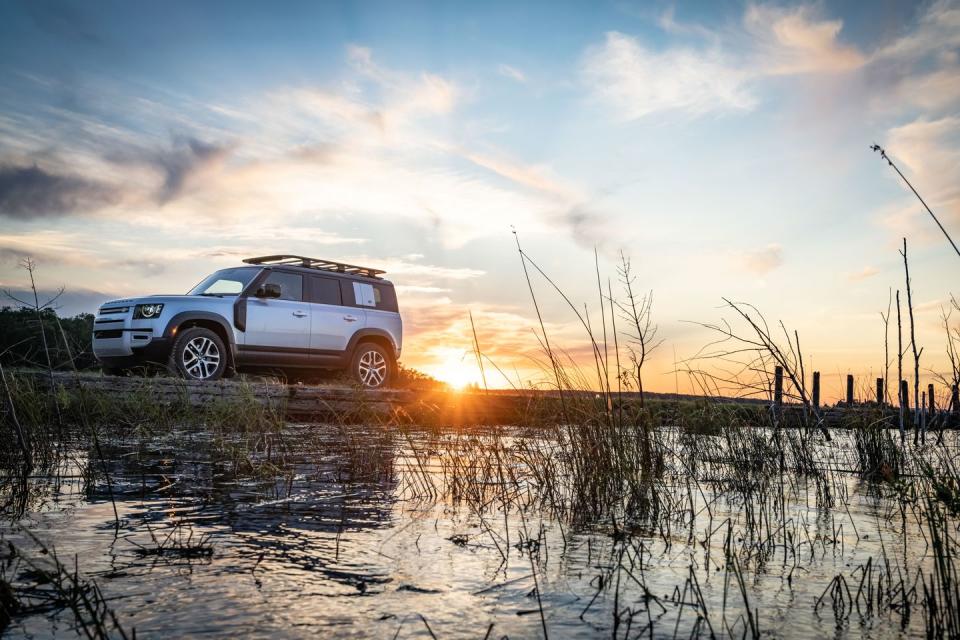
We met our match at the Marble Head rock staircase. Descending the jagged, rain-slicked steps would've been easy, but after a thorough search of the front end, we couldn't find any tow hooks—a necessary backup plan should the return trip prove unmanageable. Yes, the 110 boasts a standard two-speed transfer case and legit off-road stats, with a 38.0-degree approach angle, 40.0-degree departure angle, and 28.0-degree break-over angle—figures that, for the most part, beat those of many Broncos and Wranglers. Plus, its optional rear and center diffs are lockable. But the front diff—which is paramount for pulling up and over objects—is open. So we turned back, which kept the 110's rocker panels and pride intact but left us with regret. Our ruing only intensified after we made the 360-mile drive home and learned of a hidden tow eye behind an access panel in the bumper.
The base 110 and S model come with a 296-hp turbocharged 2.0-liter inline-four. Moving up a notch to the SE adds muscle and complexity. Its 3.0-liter inline-six hangs a 48-volt motor-generator off the front, and under acceleration, an electrically driven supercharger force-feeds the engine until the turbo spools. At full boil, the six-cylinder produces 395 horsepower and 406 pound-feet of torque. Off idle, the engine has a diesel thrum and lacks refinement. But a heady plateau of torque from 2000 to 5000 rpm is off-road approved, and a bulletproof ZF eight-speed automatic tackles the shifting duties.
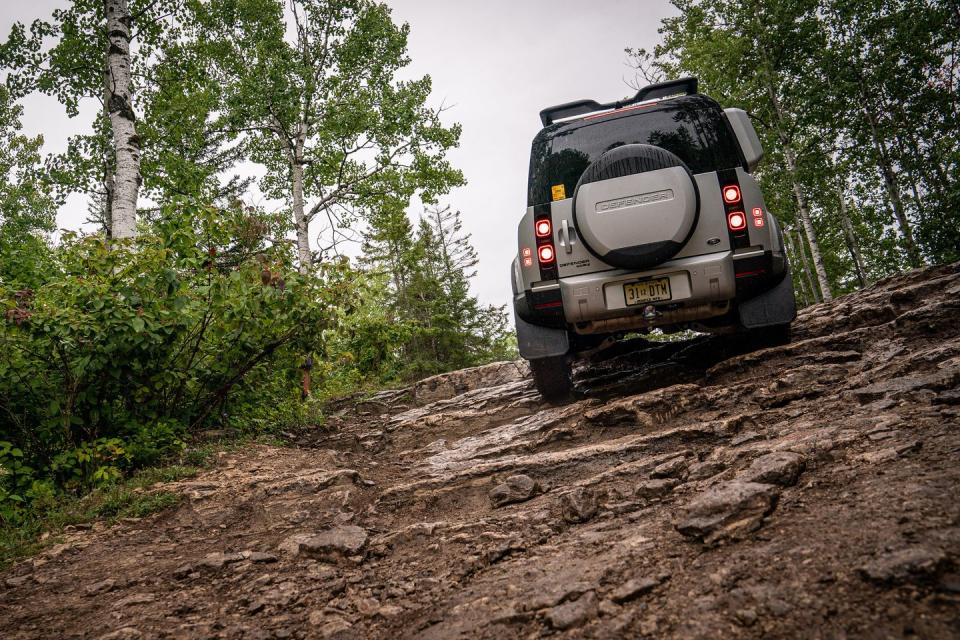
With Rock Crawl mode selected and the 2.93:1 low-range gearset engaged, the six doesn't impress as we ascend rock shelves. But once we push past the throttle's initial sluggishness, the electric blower and turbo come online with explosive thrust. Air whooshes through the snorkel, which might as well be an intake megaphone, and the optional 20-inch Goodyear Wrangler All-Terrain Adventure tires spin furiously.
On the way down, the brake-by-wire system catches our attention with the absence of feel. An initial dead zone in the pedal stroke is followed by aggressive bite that's difficult to modulate. This pairing makes two-pedal driving a challenge; passengers' heads will thrash like they're in a mosh pit. For the offbeat path, Land Rover offers a cruise-control system called All-Terrain Progress Control, but where's the fun in letting the computers figure things out?

The Defender's 6.3-second run to 60 mph and 14.8-second sprint through the quarter-mile are practically irrelevant on Drummond Island. But in the hands of pavement pounders, where most Defenders will live out their lives, these are formidable numbers for something that weighs 5773 pounds and has the aerodynamic profile of a bulldozer. Why Land Rover had to make this thing as heavy as a full-size pickup, we don't know.
The heft hurts the Defender's braking abilities. Panic stops from 70 mph take a lengthy 204 feet, and the all-terrain tires don't help. Fortunately, the steering is light during tight maneuvers and builds up the perfect amount of weight as speed increases. If it weren't for the roof rack, the cabin would be a serene place, as it's seriously isolated from the outside. The air springs feel just right on the open road. The Defender is shockingly stable at triple-digit speeds, something that stick axles and recirculating-ball steering would never allow.
The interior is tasteful. An exposed, structural magnesium beam spans the dash, with grab handles on either end to help you pogo your way into a seat. The shelf in front of the beam provides some space to store clutter. The exposed bolts in the door panels and center console look appropriately rugged without being too cheesy. There's even a plastic floor, but it lacks a drain, so don't expect to rinse away a weekend's worth of fun. First- and second-row riders will enjoy bountiful room, and though Land Rover offers a third row, it's a $1700 option worth skipping. There's barely enough legroom back there for someone without lower limbs.

It wouldn't be the complete Land Rover experience without a few electrical gremlins. Over the course of a week, a false alert for the power-steering system popped up, the camera system died, and the otherwise smooth 48-volt stop-start system once failed to restart the engine at a stoplight. A simple key cycle remedied these issues, but the satellite radio bricked itself and never returned.
The SE's $63,600 starting price may seem steep, but consider that First Edition Broncos require about the same. And this is a proper luxury SUV, offering a level of richness that the common-as-kudzu Jeeps in this segment can't match. It may be a touch soft by hardcore off-road standards, but that doesn't make it less of a Defender. It's merely a more modern version that's still the archetype of a no-nonsense off-roader.
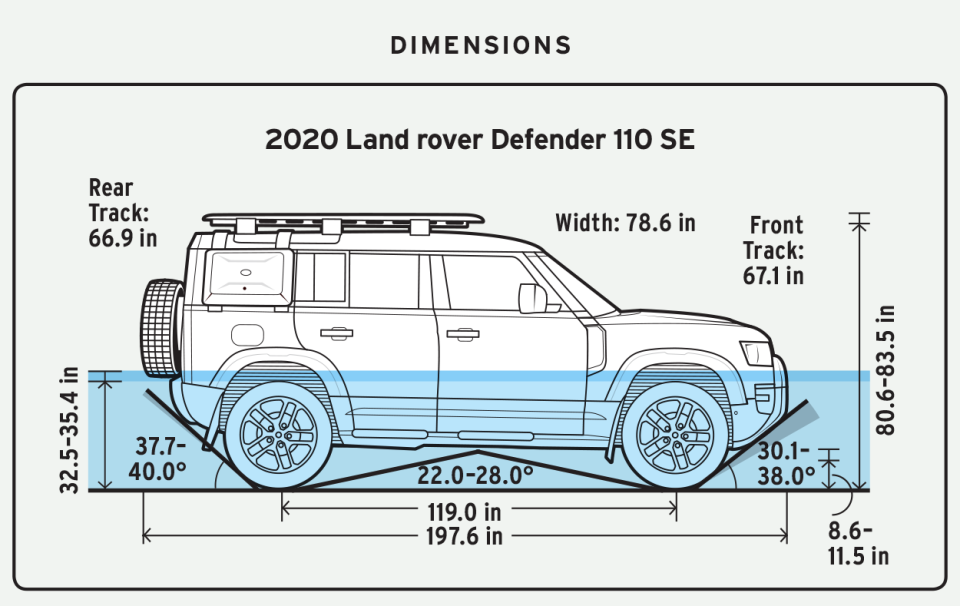

You Might Also Like

 Yahoo News
Yahoo News 
